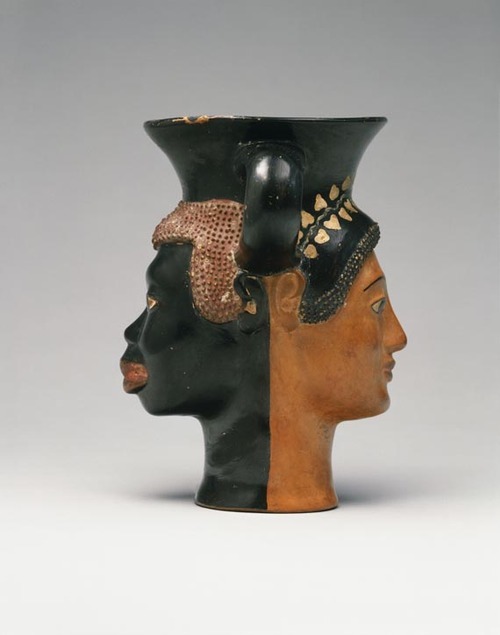Here is the link:
See: The Meaning of Skin Color in Eighteenth Dynasty Egypt:
https://www.academia.edu/353602/The_..._Dynasty_Egypt
Description
One of the most obvious stylistic features of Athenian black-figure vase painting is the use of color to differentiate women from men. By comparing ancient art in Egypt and Greece, Tan Men/Pale Women uncovers the complex history behind the use of color to distinguish between genders, without focusing on race. Author Mary Ann Eaverly considers the significance of this overlooked aspect of ancient art as an indicator of underlying societal ideals about the role and status of women. Such a commonplace method of gender differentiation proved to be a complex and multivalent method for expressing ideas about the relationship between men and women, a method flexible enough to encompass differing worldviews of Pharaonic Egypt and Archaic Greece. Does the standard indoor/outdoor explanation—women are light because they stay indoors—hold true everywhere, or even, in fact, in Greece? How “natural” is color-based gender differentiation, and, more critically, what relationship does color-based gender differentiation have to views about women and the construction of gender identity in the ancient societies that use it?
The depiction of dark men and light women can, as in Egypt, symbolize reconcilable opposites and, as in Greece, seemingly irreconcilable opposites where women are regarded as a distinct species from men. Eaverly challenges traditional ideas about color and gender in ancient Greek painting, reveals an important strategy used by Egyptian artists to support pharaonic ideology and the role of women as complementary opposites to men, and demonstrates that rather than representing an actual difference, skin color marks a society’s ideological view of the varied roles of male and femal
- See more at:
http://www.press.umich.edu/3080238#sthash.D1NS4JUd.dpufhttps://www.academia.edu/353602/The_..._Dynasty_Egypt
The way that people are portrayed in ancient art is not about making stereotypes for simple people, or at least not in the way that you mean if I understand you. Their art reflects their world view, the symbolic meaning of certain colors or forms, their aesthetic sense, or what they considered beautiful, their social and gender class structure, the value given to certain techniques etc.
So, for example, when looking at ancient art people have to be aware that certain conventions were followed whereby women were almost always portrayed as having lighter skin than men, and the wealthy were portrayed as lighter than field workers, for example. As I've pointed out before, ancient people weren't stupid. They could see that work in the fields made people get tan. Ergo, tan skin equals lower status...well, unless the man was a warrior, who would be expected to be hardened by the elements. Today, it's reversed. A tan indicates you're wealthy enough to get away from cold and grey skies in winter and go broil in the sun on a Caribbean Beach. Many things change, but the hunger of the human animal for status symbols never changes, even when the symbol is baked into his own skin.
See:
http://www.press.umich.edu/3080238
Tan Men/Pale Women
Then, one also has to consider that certain finishes were very prized because of the difficulty in achieving them. For both the Greeks and the Etruscans, the so called "black figure" pottery was a stylistic and aesthetic
choice partly based on the fact that this method was extremely difficult and sophisticated.
http://en.wikipedia.org/wiki/Black-figure_pottery
Within that style, they observed certain conventions:
http://www.ancient.eu/Black_Figure_Pottery/
"Certain colour conventions were adopted such as white for female flesh, black for male. Other conventions were an almond shape for women’s eyes, circular for males, children are as adults but on a smaller scale, young men are beardless, old men have white hair and sometimes stoop, and older women are fuller-figured. Some gestures also became conventional such as the hand to the head to represent grief. Another striking feature of the style is the lack of literal naturalism. Figures are often depicted with a profile face and frontal body, and runners are in the impossible position of both left (or right) arms and legs moving forward. There was, however, some attempt at achieving perspective, frontal views of horses and chariots being especially popular."
So, it's a mistake to look at Greek vases and think that Greek men were black and Greek women were white. Likewise, Egyptian portrayals of other ancient people has to be cautiously interpreted, although it's clear that they wanted to indicate a difference between Sub-Saharan Africans, themselves, and people like the Libyans and Syrians. We also have written documents, as Drac pointed out, to the effect that there were some fairer "Libyans".
The bottom line is that I think you can get some clues about the phenotypes of ancient peoples from their art, but it has to be done cautiously and with an understanding of their art and culture, including all the issues discussed above.






